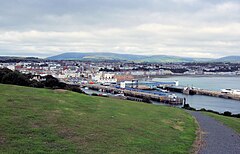Douglas, Isle of Man
Douglas
|
|
|---|---|
 A view of Douglas Bay from Douglas Head, showing the Ferry Terminal |
|
| Douglas shown within the Isle of Man | |
| Population | 27,938 (2011 Census) |
| OS grid reference | SC379750 |
| Parish | Douglas |
| Sheading | Middle |
| Crown dependency | Isle of Man |
| Post town | ISLE OF MAN |
| Postcode district | IM1 / IM2 |
| Dialling code | 01624 |
| Police | Isle of Man |
| Fire | Isle of Man |
| Ambulance | Isle of Man |
| House of Keys |
Douglas North Douglas East Douglas South Douglas West |
| Website | www.douglas.im/ |
Douglas (Manx: Doolish) is the capital and largest town of the Isle of Man, with a population of 27,938 (2011). It is located at the mouth of the River Douglas, and on a sweeping bay of two miles. The River Douglas forms part of the town's harbour and main commercial port.
Douglas was a small settlement until it grew rapidly as a result of links with the English port of Liverpool in the 18th century. Further population growth came in the following century, resulting during the 1860s in a staged transfer of the High Courts, the Lieutenant Governor's residence, and finally the seat of the legislature, Tynwald, to Douglas from the ancient capital, Castletown.
The town is the Island's main hub for business, finance, legal services, shipping, transport, shopping, and entertainment. The annual Isle of Man TT motorcycle races start and finish in Douglas.
In the absence of any archaeological data, the origins of the town may be revealed by analysis of the original street and plot pattern. The discovery of a bronze weapon in central Douglas, and the large Ballaquayle Viking treasure hoard on the outskirts, both in the 1890s, hint at the early importance of the site now occupied by Douglas. Scholars agree that the name of the town derives from Early Celtic 'Duboglassio' meaning 'black river'. Douglas is twice referred to in the Monastic 'Chronicle of the Kings of Man and the Isles': first in 1192, when the monks of St Mary's Abbey at Rushen were transferred there for a four-year stay; then again in 1313, when Robert (Bruce), King of Scotland, spent the night at the 'monastery of Duglas' on his way to seize Castle Rushen. These may be references to the site of the later Nunnery, a little upstream from the port.
The first detailed documentation shows that in 1511 there were only thirteen resident households in the settlement clustered north of the harbour, most of the property there classifying as "chambers" (unoccupied, unheated, single-celled structures) for which rent was paid by non-residents including clergy, officials and landowners from elsewhere on the Island. This suggests that the origins of the town's nucleus were as a non-urban port. Current speculation links the store buildings with the Irish Sea Herring fishery, and the import/export trade.
...
Wikipedia

